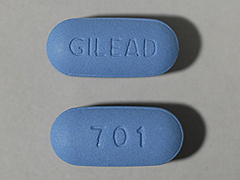Truvada (emtricitabine/tenofovir disoproxil fumarate)
Janis C. Kelly
May 11, 2012 — The US Food and Drug Administration's (FDA's) Antiviral Drugs Advisory Committee has strongly backed approval of the first-ever drug for the prevention of sexually acquired HIV-1 infection.
In a marathon 12-hour session, the panel recommended approval of a supplemental indication for Truvada (emtricitabine/tenofovir disoproxil fumarate) for preexposure prophylaxis (PrEP) in:
- HIV-uninfected men who have sex with men,
- HIV-uninfected partners in serodiscordant couples, and
- other individuals (such as sex workers) who are at risk of acquiring HIV through sexual activity.
The panel also urged the agency to "put some teeth into" Gilead's proposed risk evaluation and mitigation strategy (REMS) because of concerns that healthy people taking Truvada for HIV prevention will be harmed if they become infected with HIV and do not change from single-drug PrEP prophylaxis to a 3-drug combination antiretroviral treatment regimen, that continuing single-drug Truvada after HIV infection will lead to development of Truvada-resistant viral strains, and that taking the PrEP regimen increases the risk for adverse effects, particularly kidney damage.
The hearing occurred against the background of growing concern that the number of new HIV infections in the United States has remained at about 50,000 per year for the past decade. Most (75%) new HIV infections are in men. Black men have the highest incidence of new HIV overall: Incidence is 8 times higher in blacks and 3 times higher in Hispanics/Latinos than in whites.
The main driver of HIV transmission in the United States is unprotected anal sex between men who have sex with men (MSM), who represent about 2% of the population older than 13 years but account for from 56% to 61% of new HIV infections annually. The number of new HIV infections among 13- to 29-year-old MSM increased 38% from 2006 to 2009, largely because of a 48% increase among young black MSM, according to the FDA background document. Proponents of the Truvada PrEP approach hope that the daily pill will be "another tool in the toolbox" for reducing the continuing spread of HIV.
In support of the requested new indication, Gilead Science presented data from the Preexposure Prophylaxis Initiative (iPrEx) trial, which found that MSM participants who took Truvada daily had a 44% reduction in HIV incidence over the course of 1.2 years of follow-up compared with placebo. The study participants also received monthly HIV testing, free condoms, treatment for other sexually transmitted diseases, and routine counseling and were paid for participation in the study. Even with this supportive structure, nearly half of the study participants had no detectable level of Truvada when tested, suggesting that they were not taking the drug regularly.
Results of the iPrEx study were published online November 23, 2010, in the New England Journal of Medicine. Several speakers during the public comments part of the committee meeting reported that Truvada is already being seen as a "medical condom" (in the words of AIDS Healthcare Foundation's Whitney Engeran-Cordova) and might be taken intermittently or as a "party drug," leading to rapid development of Truvada-resistant HIV.
The resistance problem is one reason the FDA took the unusual step of asking that Gilead design a REMS, something that typically happens only when there are concerns about drug toxicity. The proposed REMS includes mailings to about 200,000 healthcare providers; a medication guide for uninfected individuals; voluntary training for primary care prescribers, infectious disease specialists, emergency medicine physicians, obstetrician-gynecologists, and addiction specialists on the importance of strict adherence to daily dosing and of regular monitoring of HIV serostatus; a prescriber safety brochure; an individual safety brochure; and a "TRUVADA for PrEP" wallet card for the patient. The REMS does not require participation by either physician or patient in the education program before making Truvada available.
The REMS plan also does not require a negative HIV test ("documentation of safe use condition") for a patient to receive each 30-day supply of Truvada, which sparked considerable criticism from the panel.
The possibility of "behavioral compensation" (reduced condom use by a patient who assumes protection from the pill) was dismissed by Gilead speakers but remained a concern for several panelists, who noted that condoms, used correctly, are more than 90% effective at preventing HIV infection.
Panelist and speakers also questioned whether the 44% protection seen in the clinical trial would also occur in "real-world" settings, as it requires daily use by a healthy person of a drug that costs $13,000 per year and carries some risk for adverse effects.
The committee voted 19 to 3 in favor of Truvada PrEP for HIV-uninfected MSM, 19 to 2 (1 abstention) in favor of Truvada PrEP for HIV-uninfected partners of those with HIV, and 12 to 8 (2 abstentions) in favor of Truvada PrEP for others at risk of acquiring HIV through sexual activity. The panel also favored monthly HIV testing and regular monitoring of renal function for those taking Truvada PrEP.
The panel ran out of time before full consideration of the proposed REMS, of postmarketing studies that should be required, and on whether current evidence makes the conduct of placebo-controlled trials of primary HIV prevention unethical.
The FDA is expected to make a final decision on the Truvada prophylaxis indication by June 15. It is already approved as part of combination therapy for treatment of HIV infection.
FDA Antiviral Drugs Advisory Committee Meeting. Silver Spring, Maryland. May 10, 2012.

No comments:
Post a Comment